MSI GE40 Review: a Slim Gaming Notebook
by Jarred Walton on July 16, 2013 3:00 AM ESTMSI GE40 Gaming Performance
Our notebook gaming suite is now set for 2013, and I'm toying with the addition of Company of Heroes 2 as a second RTS/strategy data point. We’re still collecting performance results for CoH2, however, so for now I’ll refer you to Mobile Bench for those numbers. Let's just say that the game can bring even powerful notebooks to their knees.
We’ve also got the GTX 680M courtesy of the Alienware M17x R4 in the gaming charts, along with the other notebooks from the previous page. Here are the charts, and please take the time to read the commentary before trying to draw too many conclusions as there’s more going on than may at first be apparent. We’ll start with the Value charts, where the CPU becomes even more of a factor, and then move on to the Mainstream charts.
Notebook “Value” Gaming Performance
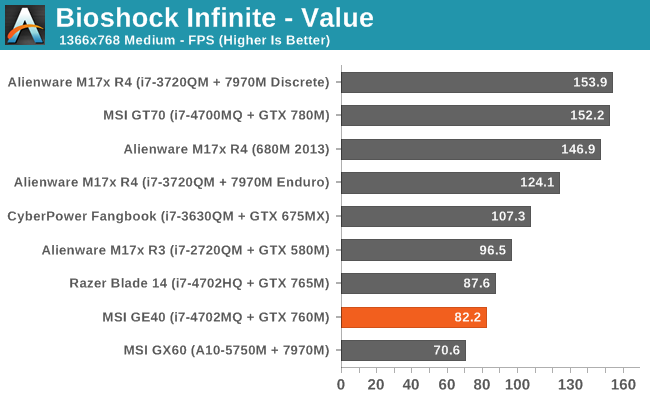
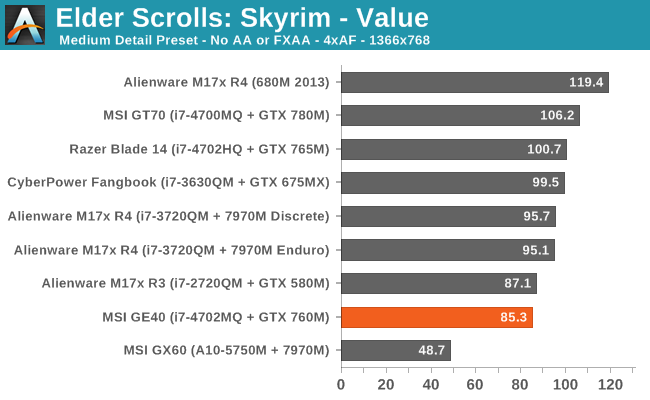
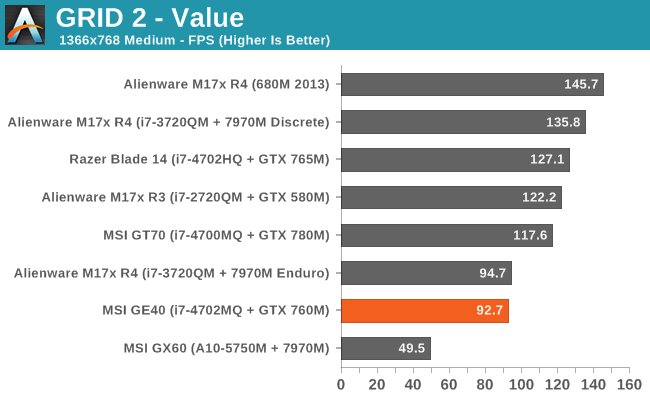
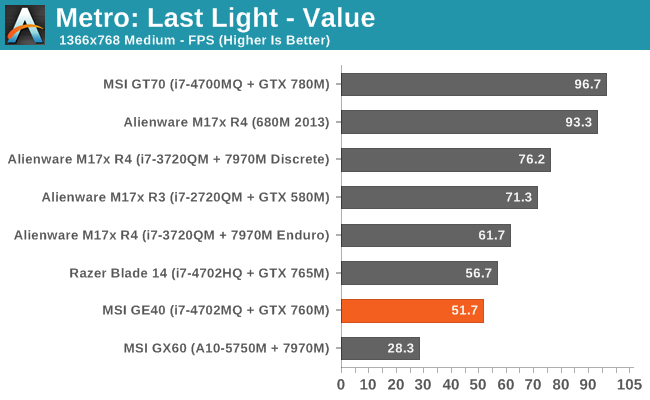
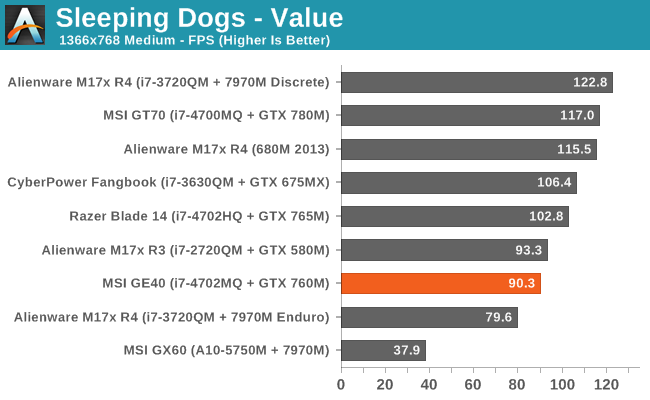
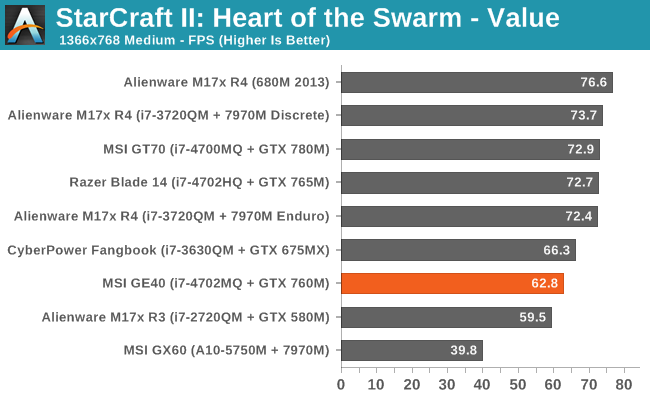
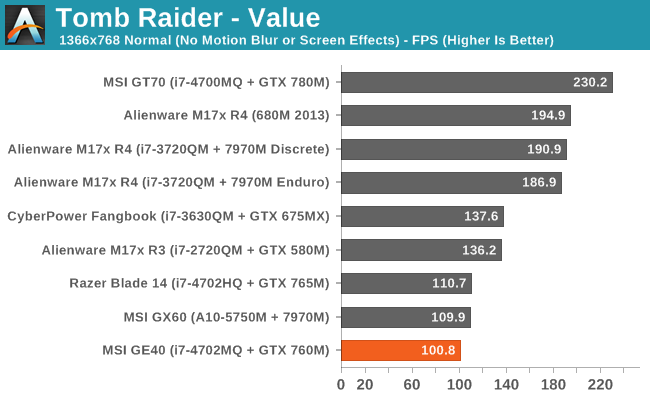
Notebook “Mainstream” Gaming Performance
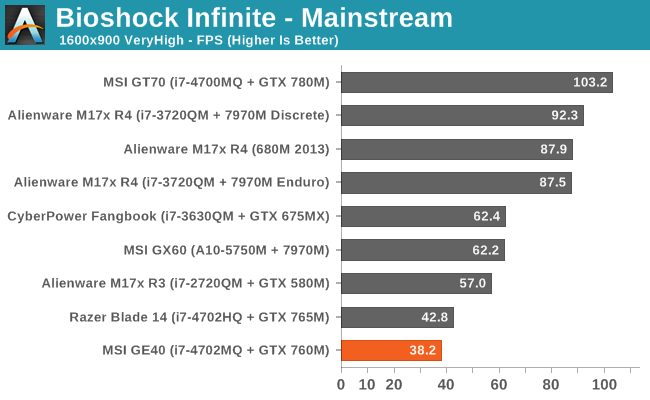

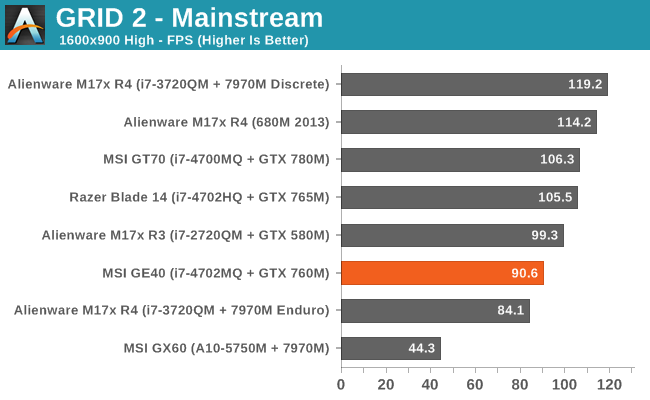
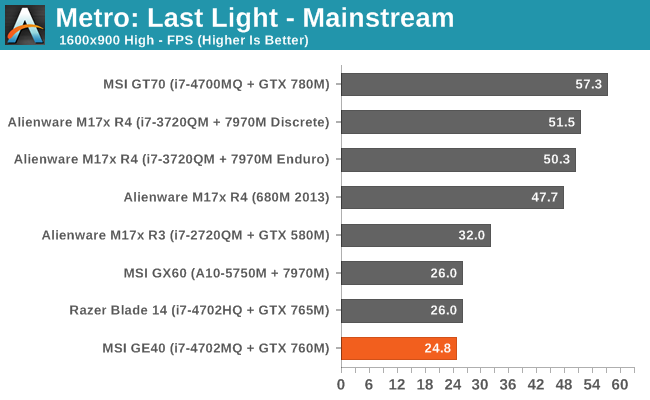
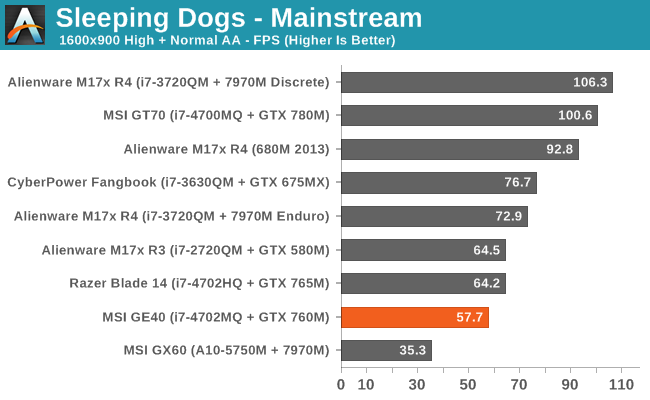
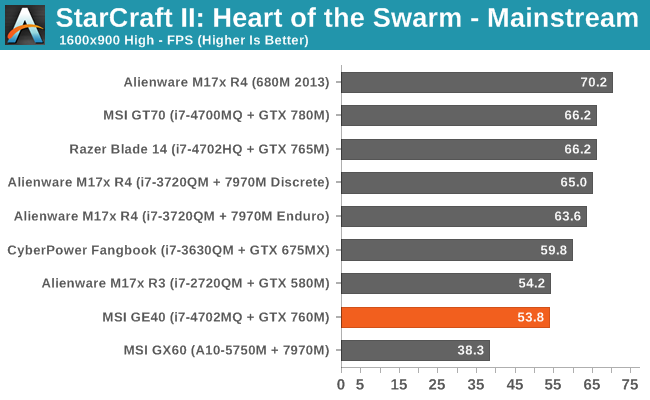
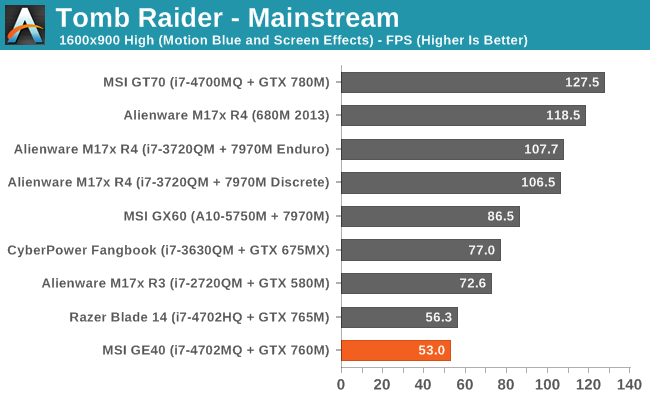
First, let me get this out of the way: the GTX 780M performance looks rather poor in many of these gaming benchmarks. The reason isn’t that our benchmarks are inherently flawed or even that the MSI GT70 is a “lemon”; rather, we’re looking at lower quality settings where the CPU plays a much greater role. We have another laptop (Clevo P157SM) with i7-4700MQ and GTX 780M, and while it’s sometimes up to 7% faster than the GT70, there are also instances where the GT70 wins by 5%; on average, our P157SM numbers average out to 0.01% faster at our Value settings and 1.3% faster at our Mainstream and Enthusiast settings.
The long and short of it is that the GTX 780M needs more CPU to really stretch its legs in some games; we’ll have a full review and investigation of CPU scaling with the GTX 780M in the future, but no matter how crazy it might seem, the results from our GT70 review aren’t far off of what you can expect in the games we’ve benchmarked at the settings we’ve used. Certain titles in particular are very CPU limited (Skyrim and StarCraft II), even at higher quality settings, and the i7-3820QM ends up being faster than the i7-4700MQ by a decent margin. (Note that the i7-4700MQ is really the replacement for the i7-3610QM, so the 3820QM is two steps above the 4700MQ.)
We can get a better idea of where the CPU matters most and where it matters least by looking at the performance of the MSI GX60. The HD 7970M is definitely faster than the GTX 760M and GTX 765M in most disciplines (e.g. look at the M17x 7970M discrete results; on average it’s 29%/41% faster than the 765M at Value/Mainstream and 50%/61% faster than the 760M), so when it loses—especially by a large margin—to the GE40, we’re looking at CPU bottlenecks. The only Value benchmark where the GX60 beats the GE40 is Tomb Raider; elsewhere it’s anywhere from 14% (Bioshock) to 58% (Sleeping Dogs) slower, and on average the GE40 runs through our Value suite 47% faster than the GX60! At the more demanding Mainstream settings, the gap narrows and the GX60 now claims wins in Bioshock, Metro: Last Light, and Tomb Raider; the GE40 is still 15% faster on average, with large wins in Skyrim, GRID 2, and Tomb Raider. It’s only at our Enthusiast settings that the GX60 starts to win in a majority of the games we’re testing. (Those scores aren’t shown here but they’re available in Bench—we figure with a 1600x900 panel and moderate GPU we didn’t need to show maxed out 1080p performance, but it’s still interesting to see how the GTX 760M handles those settings.)
Other than the GTX 780M “oddities”, the MSI GE40 places about where we’d expect. It’s always behind the Razer Blade 14, though again there appear to be cases where the Blade is hitting higher CPU turbo speeds. On paper the GTX 765M should at best provide 30% more performance than the GTX 760M (thanks to the higher core clocks). The average lead of the Razer Blade is 16% at our Value settings and 14% at our Mainstream settings, but the GRID 2 Value result is 37% faster on the Blade. Considering the increase in cost, though, that’s probably a performance tradeoff many would be willing to make.
Overall, the GE40 gets more than 60FPS in nearly every title we tested at 1366x768 Medium settings, and more than 30FPS at 1600x900 High settings. The one exception from our graphs: Metro: Last Light, where you can expect reasonable frame rates at 1600x900 Value settings but our Mainstream settings prove to be too much. Company of Heroes 2 is another brutal game, with Medium/Low 1366x768 settings getting a paltry 29FPS on the GE40 while the High/Medium 1600x900 results drop down to 23FPS. Hopefully a patch or new drivers will improve CoH2 performance—sooner rather than later—because right now the built-in benchmark can make even a GTX 780M struggle (e.g. 55FPS at our Value settings, 51FPS at Mainstream, and 23FPS at Enthusiast).










93 Comments
View All Comments
GuniGuGu - Tuesday, July 16, 2013 - link
Awesome review; Between this and the Razer Blade... only last portable gaming laptop to cover is the Clevo w230st :) Any plans jarred?GuniGuGu - Tuesday, July 16, 2013 - link
Also a big point of discussion for the Clevo w230st are the CPU options.. 4700, 4702, 4800 & 4900... It seems most on the forum are recommending the 4800.. but reading this it sounds like even the 4702 can get quite toasty....JarredWalton - Tuesday, July 16, 2013 - link
I think we'll be getting one in at some point in the next couple of weeks -- I'm heading out on vacation, so if Dustin doesn't get one before I return I'm sure I can find one. :-)GuniGuGu - Wednesday, July 17, 2013 - link
Damn, not sure I can wait that long before ordering it... Oh well, would love to see it run through the paces of an in-depth review all the same. Tossing up on the CPU's, the lower TDP of the 4702 is tempting over faster clocks.realjetavenger - Tuesday, July 16, 2013 - link
Actually, I'd also like to see the Alienware 14. This is a direct competitor to the Razer with what should be a much better lcd panel.mountcarlmore - Tuesday, July 16, 2013 - link
The Alienware is more than twice as thick and weighs over 6 pounds, its in a total different class from these latpops...noeldillabough - Tuesday, July 16, 2013 - link
True, but its in still in the running, I'd pick a thicker machine if it was noticeably faster.JarredWalton - Tuesday, July 16, 2013 - link
I don't expect it to be much faster at all -- we're still looking at i7-4700MQ with GTX 765M. With that CPU and GPU and a 256GB mSATA SSD + 750GB HDD, the cost is $1800. You also get a 1080p LCD. The display is really going to be the reason to go with the Alienware 14 I think, and to get that you'll have a heavier laptop that's twice as thick. On the other hand, I expect it will run cooler and quieter thanks to the size, but over six pounds means you can readily compare the AW14 to 15.6" options out there.The Clevo W350ST is a 15.6" laptop with similar dimensions to the AW14, and with similar components it can be had for around $1500. Not that I expect the Clevo W350ST to be built better than the AW14, but the dimensions are 14.72" x 9.84" x 0.64"~1.68" and it weighs 5.95 pounds where the 14" AW measures 13.31" x 10.17" x 1.58"~1.64" and weighs 6.12 lbs. So the Clevo is wider but not as deep and has more of a wedge shape, and it weighs a bit less.
Anyway, we're definitely going to see about reviewing the Alienware 14 and 17 as soon as we can.
hfm - Wednesday, July 17, 2013 - link
From all the reviews and user commentary I've read, the Alienware 14 is definitely not exactly "cool and quiet" some users have complained about how loud it is. Also, be prepared for the Alienware 14 to play games at lower frame rates than the Razer due to 33% more pixels at native resolution.Bob Todd - Wednesday, July 17, 2013 - link
"Cool and quiet" with these kinds of specs in a reasonably portable machine doesn't really seem possible with the current crop of CPUs/GPUs. Do you want quiet or do you want adequate cooling? I'm not really comfortable at all with a brand new machine hitting 98 degrees Celsius under load, or even the 93 degrees the Blade hit. I'll deal with a louder fan if it means I don't have to worry as much about throttling (or heat induced crashes). Especially on a gaming focused machine where I'd have the sound cranked up a bit or headphones in while using it the way it was intended.